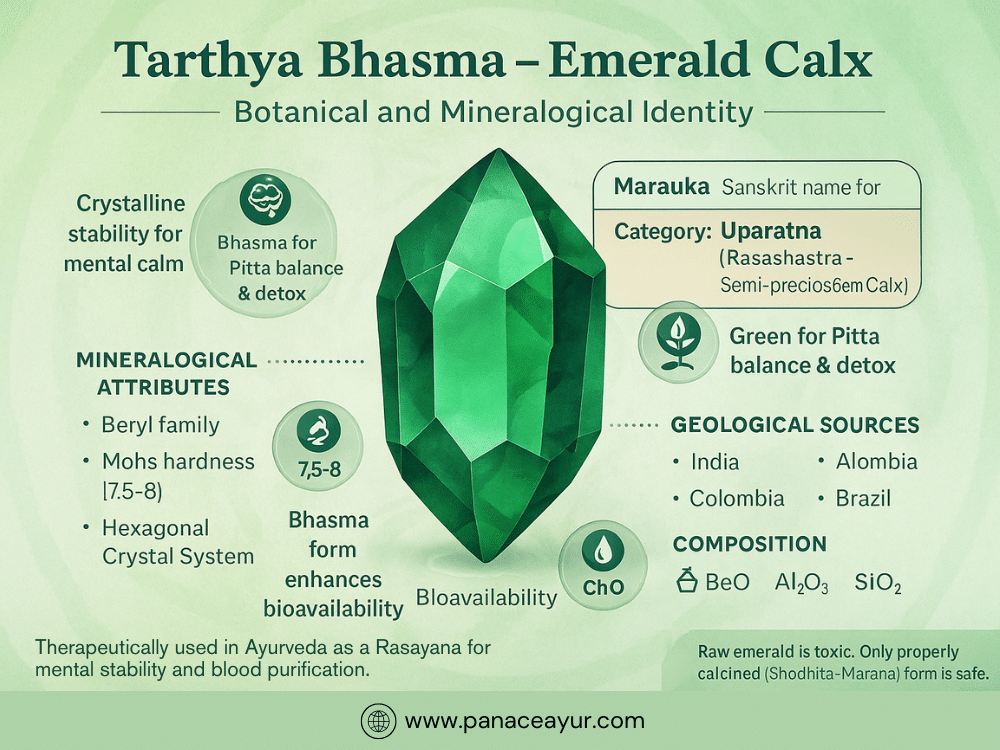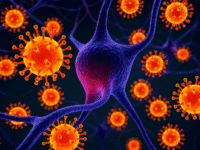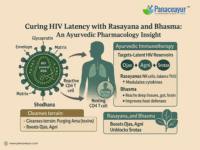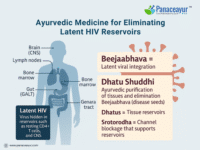- Ayurvedic Origin and Classical References
- Botanical and Mineralogical Identity
- Botanical and Mineralogical Identity
- Clinical Indications in Ayurveda
- Dosage and Anupana
- Safety Profile and Toxicological Review
- Scientific Research and Validation
- Ojas Strengthening (Vitality Enhancement)
- Antipyretic Action (Jwara Nashaka)
- Digestive and Metabolic Disorders
- Relieves Shwasa (Respiratory Distress)
- Excretory System Benefits
- Wound Healing and Detoxification
- Cooling and Anti-inflammatory Properties
- Mental and Cognitive Benefits
- Longevity and Strength
- References
Tarthya Bhasma, also known as Panna Bhasma or Marakata Bhasma, is a unique Ayurvedic mineral preparation derived from the incineration of purified emerald gemstones. It belongs to the category of Uparatna—semi-precious minerals that hold therapeutic value comparable to primary gems like Mukta (pearl) and Heera (diamond), but are more accessible and cost-effective for general use [1].
Traditionally, Tarthya Bhasma is recognized for its profound influence on the mind, heart, and liver, and is often used in the management of chronic fevers, neuropsychiatric disorders, and toxic blood conditions. In Ayurvedic philosophy, emerald is considered to possess Sheeta Virya (cool potency), Madhura Rasa (sweet taste), and Snigdha Guna (unctuous quality), making it especially useful for Pitta-Vata disorders such as inflammation, mental agitation, and cardiac imbalances [2].
The calx is prepared through meticulous purification (Shodhana) and incineration (Marana) methods that detoxify the raw gem and render it bioavailable. Unlike raw emerald powders or gemstone ash sold in unregulated markets, true Tarthya Bhasma undergoes multiple cycles of calcination under controlled Ayurvedic protocols—transforming the crystalline silicate matrix into a soft, absorbable compound that integrates into the body’s cellular pathways [3].
In modern integrative medicine, emerald calx is attracting attention for its trace element content, particularly beryllium, aluminium, and silicate compounds, which may exert neuroprotective, anti-inflammatory, and adaptogenic effects when properly detoxified and calcined [4]. Despite its rarity in Western pharmacopoeia, Ayurvedic practitioners in India have used it for centuries as a mental stabilizer, liver protector, and gentle Rasayana (rejuvenative) agent [5].
The preparation is most often prescribed alongside cow ghee, honey, or Brahmi juice, tailored to the patient’s constitution (Prakriti). It is favored in chronic conditions where both mind and body require restoration, especially in cases of toxic overload, post-infectious fatigue, and emotional instability. Moreover, Tarthya Bhasma offers a cost-effective alternative to more expensive gem preparations like Swarna Bhasma (gold calx) or Mukta Pishti (pearl powder), without compromising therapeutic potency when correctly formulated [6].
Ayurvedic Origin and Classical References

Tarthya Bhasma has its roots in classical Ayurvedic texts that describe the medicinal potential of semi-precious gems, particularly emerald (Marakata), under the category of Uparatna—a sub-group of therapeutic minerals and gems acknowledged for their affordability and effectiveness. The foundational documentation of emerald’s transformation into a usable calx is found in texts such as Rasa Ratna Samucchaya, Rasa Tarangini, and Ayurveda Sara Sangraha [1].
In Rasa Ratna Samucchaya, emerald is listed under the group of Ratnas with specific mention of its mental, hepatic, and cardiac benefits when properly processed through Shodhana (purification) and Marana (calcination) [2]. The text outlines the initial purification steps using sour liquids like lemon juice or Kanji to remove surface impurities, followed by grinding with specific herbal juices and subjecting the material to Puta (calcination) for complete transformation.
Rasa Tarangini, a widely respected text in the Rasashastra tradition, devotes part of Taranga 24 to explain the therapeutic potential of Marakata, particularly in diseases of the mind (Unmada, Apasmara), disorders of the liver and spleen (Yakrit-Pliha Vikaras), and chronic fevers (Jwara) [3]. The shlokas describe its use in combination with Brahmi (Bacopa monnieri), Vacha (Acorus calamus), and Shankhapushpi for enhancing cognitive clarity and reducing emotional instability.
Ayurveda Sara Sangraha, in its Ratna Rasayana section, outlines specific combinations in which Panna Bhasma is used alongside Mukta Pishti and Abhrak Bhasma to treat manasik rogas and constitutional weakness following chronic diseases [4]. It is also said to improve Rakta Dhatu, stabilize Ojas, and function as a Vishaghna (detoxifying agent) in cases of Garavisha (environmental toxins and low-grade poisoning).
Though not as elaborated upon as primary gems like diamond (Heera) or ruby (Manikya), emerald is consistently mentioned as a medhya ratna (intellect-promoting gem) across Rasashastra texts. Some editions of Ananda Kanda and Dhatu Ratnavali include references to its use in both pediatric mental illness and adult psychiatric disorders [5]. This reflects an ancient understanding of mind-body medicine wherein specific mineral frequencies and elemental qualities were believed to resonate with different Srotas (channels) of the body.
The metaphysical qualities attributed to emerald in Ayurveda are also notable. It is believed to calm the manovaha srotas (channels of the mind), purify raktavaha srotas (blood channels), and stabilize the emotional and energetic field of an individual. This aligns with its inclusion in formulations aimed at improving Sattva—the mental clarity and spiritual stability needed during long-term Rasayana therapy [6].
In summary, the classical texts establish Tarthya Bhasma not only as a physical therapeutic agent but also as a Sattvavardhaka (mental stabilizer) that supports higher functions of awareness and intelligence when used in properly incinerated form. Its traditional context shows it was designed for use in conditions involving chronic toxicity, neuro-psychiatric imbalance, and weakened vitality, especially where Pitta and Vata dominance required a Sheeta (cooling), Snigdha (nourishing), and Medhya (intellect-promoting) agent.
Botanical and Mineralogical Identity

Tarthya Bhasma is derived from the emerald gemstone, botanically referred to as Marakata in Ayurvedic literature. Though not botanical in the classical plant sense, its identity and therapeutic relevance stem from its mineralogical structure—a beryllium aluminium cyclosilicate compound with the chemical formula Be₃Al₂Si₆O₁₈ [1]. The presence of chromium and vanadium ions imparts its distinctive deep green hue, which is considered symbolically and pharmacologically cooling (Sheeta Virya) in Ayurvedic energetics [2].
In Ayurvedic Rasashastra, emerald belongs to the Ratna group (gems and minerals) and is specifically classified under Uparatna, a category of semi-precious therapeutic substances that possess milder yet effective properties compared to the nine primary gems (Navaratna) [3]. Despite being classified as semi-precious, Marakata is highly valued in Ayurvedic practice for its effect on the Manovaha Srotas (mental and nervous channels), Raktavaha Srotas (blood pathways), and Hridaya (heart) functions [4].
From a modern mineralogical standpoint, emerald is a hexagonal crystal belonging to the beryl family, with a Mohs hardness of 7.5–8, making it a durable gemstone used both ornamentally and medicinally [5]. It is generally composed of:
- Beryllium oxide (BeO)
- Aluminium oxide (Al₂O₃)
- Silicon dioxide (SiO₂)
- Trace amounts of chromium, vanadium, and iron
These elements, when detoxified and calcined properly during the Marana process, yield a soft greenish-white calx with no crystalline reflection, ideal for internal use. Unprocessed emerald is not used directly in medicine, as its raw form contains toxic beryllium, which can be harmful if ingested without appropriate detoxification procedures [6].
Geologically, emeralds are sourced from various parts of the world. Traditional Ayurvedic texts refer to emeralds from Bharata Khanda (ancient India), while modern pharmaceutics may obtain them from:
- India (Odisha, Karnataka) – traditional and sacred origins
- Colombia – high chromium content, deeper green
- Zambia – darker tones with high iron presence
- Afghanistan and Brazil – often used for cost-effective preparations
In Ayurvedic pharmacy, the origin of the emerald significantly influences its selection for medicinal use. Emeralds with fewer inclusions (jewelry-grade clarity) are typically preferred in Rasashastra, not for decoration but because of structural purity, which improves uniformity in Bhasma preparation [7].
Furthermore, the Ayurvedic pharmacognosy of Tarthya Bhasma views the green hue as an indicator of Pitta-pacifying and Rakta-shodhaka (blood-purifying) properties. Unlike plant-derived herbs whose taste and aroma indicate therapeutic value, mineral calx like emerald is assessed through Varitaratwa (floatability), Rekhapurnata (micronization), and Nischandratva (absence of luster), confirming the complete transformation into a bioavailable medicinal ash [8].
In summary, while Tarthya Bhasma lacks a conventional botanical identity, its mineral and elemental structure—anchored in both Rasashastra tradition and modern mineralogy—makes it an important agent in mind-body detoxification, liver function support, and mental rejuvenation therapies, especially when other gem preparations are unaffordable or contraindicated.
Botanical and Mineralogical Identity
Tarthya Bhasma is derived from the emerald gemstone, botanically referred to as Marakata in Ayurvedic literature. Though not botanical in the classical plant sense, its identity and therapeutic relevance stem from its mineralogical structure—a beryllium aluminium cyclosilicate compound with the chemical formula Be₃Al₂Si₆O₁₈ [1]. The presence of chromium and vanadium ions imparts its distinctive deep green hue, which is considered symbolically and pharmacologically cooling (Sheeta Virya) in Ayurvedic energetics [2].
In Ayurvedic Rasashastra, emerald belongs to the Ratna group (gems and minerals) and is specifically classified under Uparatna, a category of semi-precious therapeutic substances that possess milder yet effective properties compared to the nine primary gems (Navaratna) [3]. Despite being classified as semi-precious, Marakata is highly valued in Ayurvedic practice for its effect on the Manovaha Srotas (mental and nervous channels), Raktavaha Srotas (blood pathways), and Hridaya (heart) functions [4].
From a modern mineralogical standpoint, emerald is a hexagonal crystal belonging to the beryl family, with a Mohs hardness of 7.5–8, making it a durable gemstone used both ornamentally and medicinally [5]. It is generally composed of:
- Beryllium oxide (BeO)
- Aluminium oxide (Al₂O₃)
- Silicon dioxide (SiO₂)
- Trace amounts of chromium, vanadium, and iron
These elements, when detoxified and calcined properly during the Marana process, yield a soft greenish-white calx with no crystalline reflection, ideal for internal use. Unprocessed emerald is not used directly in medicine, as its raw form contains toxic beryllium, which can be harmful if ingested without appropriate detoxification procedures [6].
Geologically, emeralds are sourced from various parts of the world. Traditional Ayurvedic texts refer to emeralds from Bharata Khanda (ancient India), while modern pharmaceutics may obtain them from:
- India (Odisha, Karnataka) – traditional and sacred origins
- Colombia – high chromium content, deeper green
- Zambia – darker tones with high iron presence
- Afghanistan and Brazil – often used for cost-effective preparations
In Ayurvedic pharmacy, the origin of the emerald significantly influences its selection for medicinal use. Emeralds with fewer inclusions (jewelry-grade clarity) are typically preferred in Rasashastra, not for decoration but because of structural purity, which improves uniformity in Bhasma preparation [7].
Furthermore, the Ayurvedic pharmacognosy of Tarthya Bhasma views the green hue as an indicator of Pitta-pacifying and Rakta-shodhaka (blood-purifying) properties. Unlike plant-derived herbs whose taste and aroma indicate therapeutic value, mineral calx like emerald is assessed through Varitaratwa (floatability), Rekhapurnata (micronization), and Nischandratva (absence of luster), confirming the complete transformation into a bioavailable medicinal ash [8].
Clinical Indications in Ayurveda

Tarthya Bhasma, prepared through the meticulous purification and incineration of emerald, is recognized in classical Ayurveda as a versatile mineral Rasayana. Its unique combination of Medhya (nootropic), Rasayana (rejuvenative), Vishaghna (detoxifying), Hridya (cardiotonic), and Chakshushya (eye-strengthening) properties makes it therapeutically applicable across a wide spectrum of chronic conditions.
Its cool (Sheeta), nourishing (Snigdha), and sweet (Madhura) energetic qualities render it especially effective for Pitta-Vata predominant diseases—often seen in individuals presenting with neuroinflammatory, autoimmune, or psychosomatic patterns. Below is a refined classification of its clinical indications, aligned with both classical Ayurvedic principles and modern integrative medical parallels.
1. Neuropsychiatric Disorders (Unmada, Apasmara, Chittodvega)
Tarthya Bhasma is one of the rare Uparatna preparations that exert a stabilizing effect on the Manovaha Srotas (mind channels) and Majja Dhatu (nervous tissue). It is indicated in Unmada (psychosis, mania), Apasmara (seizure disorders, temporal lobe epilepsy), and Chittodvega (anxiety spectrum disorders), where there is derangement of both Pitta (agitation, anger, hallucination) and Vata (tremor, dissociation, instability) [1].
It is often administered alongside Brahmi, Vacha, and Abhrak Bhasma in mental health protocols. In pediatric patients, its use is sanctioned (under expert supervision) for speech delay, childhood anxiety, and neurodevelopmental delay, often with Brahmi Ghrita [2].
2. Psychosomatic and Adrenal Disorders
In conditions where emotional dysregulation manifests somatically—such as heart palpitations, psychosomatic gastritis, or irritable bowel with anxiety—Tarthya Bhasma works by calming neuroendocrine chaos and stabilizing Prana and Vyana Vata. These manifestations are often found in individuals experiencing HPA-axis dysregulation, burnout syndrome, or post-traumatic emotional exhaustion [3].
In such cases, it is combined with Ashwagandha, Shankhapushpi, or Guduchi Satva in Rasayana protocols.
3. Hridaya Vikara (Cardiovascular Conditions)
Described classically as Hridya, it strengthens cardiac muscle tone, regulates rhythm, and improves parasympathetic resilience. Indicated in stress-induced tachycardia, palpitations, psychogenic hypertension, and vasovagal instability, Tarthya Bhasma is often paired with Mukta Pishti, Arjuna, and Jatamansi for cardiac-Pitta-Vata disorders [4].
4. Yakrit-Pliha Vikaras (Liver and Spleen Disorders)
Ayurvedic texts highlight its role in Pitta-based hepatobiliary disorders such as chronic hepatitis, splenomegaly, and post-malarial liver dysfunction. Its actions are both cooling and restorative to Rakta Dhatu and Pittavaha Srotas. It is used in conjunction with Bhringraj, Punarnava, or Tamra Bhasma for functional liver recovery and immunological modulation [5].
5. Jwara and Visham Jwara (Chronic Fever Syndromes)
Its Sheeta Virya allows use in low-grade recurring fevers, post-viral fatigue syndromes, and malarial-type fevers where liver congestion, splenic exhaustion, and altered immunity dominate. In such cases, it is frequently co-administered with Sudarsana Churna and Abhrak Bhasma [6].
6. Rakta Dushti and Autoimmune Inflammatory Disorders
Tarthya Bhasma’s Rakta-Shodhaka (blood purifier) effect is especially suited for chronic inflammatory skin conditions like eczema, psoriasis, rosacea, and urticaria where Rakta + Pitta vitiation is present. It is also part of advanced Ayurvedic protocols for autoimmune diseases such as lupus, dermatomyositis, and autoimmune hepatitis, due to its capacity to cool, stabilize, and restore dhatu harmony [7].
7. Graha Dosha, Bhuta Abhishanga, and Energetic Imbalances
In Bhuta Vidya (Ayurvedic psycho-spiritual psychiatry), emerald is revered for its connection with Budha Graha (Mercury)—the planet of intellect, speech, and nervous stability. Tarthya Bhasma is prescribed in children and sensitive individuals presenting with night terrors, erratic behavior, or spiritual sensitivity, especially when diagnosed with Graha Dosha [8]. Such protocols include mantra, Shankhapushpi, Vacha, and spiritual Rasayanas.
8. Ocular Disorders (Netra Roga)
As a Chakshushya Rasayana, it is employed in digital eye fatigue, photophobia, dry eye syndrome, and early retinal fatigue—conditions now widespread due to screen overexposure. Its use alongside Triphala Ghrita, Shatavari, and Yashtimadhu supports ocular regeneration and visual stability [9].
9. Menstrual and Endocrine Disorders
Though less commonly discussed, its role in Pitta-dominant menstrual disorders is clinically relevant. It aids in menorrhagia, PMS with irritability, and peri-menopausal anxiety. Combined with Shatavari, Lodhra, and Mukta Pishti, it balances hormonal disturbances linked to both emotional and hepatic origins [10].
10. Vishuchika, Ajeerna, and Gastric Toxemia
In cases where digestive inflammation and nervous instability coexist—such as hyperacidity, cyclical vomiting, and mental-emotional gastritis—Tarthya Bhasma helps regulate gastric fire without overstimulation. Often given with Elaichi, Kamdudha Ras, or Giloy Satva [11].
11. Post-Infectious and Viral Recovery
It is part of emerging Rasayana strategies for long-COVID, post-herpetic fatigue, Epstein–Barr recovery, and adrenal exhaustion. Its ability to cool inflammation, restore Rasa Dhatu, and calm the nervous system makes it a vital agent in integrative immune recovery plans [12].
Dosage and Anupana
Tarthya Bhasma is a powerful Ayurvedic preparation that must always be taken in very small doses, under the supervision of a qualified Ayurvedic practitioner. The standard dosage generally ranges from 30 mg to 125 mg, taken once or twice daily, depending on the individual’s health condition, age, constitution (Prakriti), and severity of symptoms.
In Ayurveda, medicines are often given with a supportive medium, called Anupana, to guide the herb or mineral to the appropriate system in the body. For Tarthya Bhasma, the recommended Anupana is carefully selected based on the disease and dosha imbalance:
- For mental stress, anxiety, or insomnia, it is given with cow ghee or Brahmi juice to calm the nervous system and promote mental clarity.
- In cardiac or psychosomatic conditions, it is administered with Mukta Pishti or Arjuna decoction, helping stabilize heart rhythm and ease palpitations.
- In liver and blood disorders, it is used along with Guduchi Satva, Punarnava, or Triphala decoction, supporting detoxification and cooling inflammation.
- For children with speech delay or mild neurological issues, it may be given with Brahmi Ghrita in micro-doses—always customized and monitored closely by an Ayurvedic doctor.
Its action becomes more effective when paired with Rasayana herbs like Ashwagandha, Shankhapushpi, or Mandukaparni, especially in cases of burnout, fatigue, or post-viral weakness. The medicine should be taken on an empty stomach or early morning, unless otherwise directed.
Importantly, Tarthya Bhasma is not meant for self-medication, and overdose can lead to complications, particularly in people with sensitive digestion or renal weakness. Pregnant and lactating women should avoid its use unless specifically prescribed in very low doses.
The duration of usage usually ranges from 15 days to 90 days, depending on how chronic the condition is. Longer-term Rasayana usage is always combined with dietary regulation, lifestyle modification, and periodic review by a trained Vaidya (Ayurvedic physician).
Safety Profile and Toxicological Review
Tarthya Bhasma, when properly prepared through the traditional Ayurvedic processes of Shodhana (purification) and Marana (calcination), is considered safe and effective for long-term therapeutic use. However, as with all mineral-based medicines, its safety is highly dependent on correct preparation, dosage, and clinical supervision.
In its raw form, emerald (the source of Tarthya Bhasma) contains trace amounts of beryllium, aluminium, and silicate compounds. While these are toxic in industrial or unprocessed forms, the ancient Ayurvedic process of repeated incineration and detoxification transforms the gemstone into a bioavailable and inert medicinal ash. This reduces toxicity and enhances compatibility with the human body. Classical signs of a properly prepared Bhasma include being soft to the touch, floating on water (Varitaratwa), entering the lines of fingers (Rekhapurnatwa), and having no metallic luster (Nischandratva).
Modern laboratory studies using tools like X-ray diffraction (XRD), scanning electron microscopy (SEM), and ICP-MS analysis have shown that well-prepared Bhasmas undergo significant structural changes during calcination. These transformations reduce particle size to the nano or micro scale, neutralize toxic residues, and enhance cellular assimilation [1].
That said, adulterated or poorly processed emerald calx—which is unfortunately available in some unregulated markets—can carry serious risks. Ingesting raw emerald dust, for example, may expose the body to insoluble forms of beryllium, which is a known respiratory toxin and potential carcinogen in occupational settings. This makes strict quality control essential when using any mineral-based preparation.
In Ayurveda, there are no documented cases of toxicity from traditionally prepared Tarthya Bhasma when used correctly and under Vaidya supervision. However, certain individuals should use extra caution:
- Pregnant and lactating women: Use only if explicitly prescribed in micro-doses.
- Children: Only in pediatric Rasayana protocols under close observation.
- Patients with chronic kidney disease (CKD) or electrolyte imbalance: Avoid unsupervised intake, especially if other mineral-based drugs are also in use.
When administered properly, Tarthya Bhasma can serve as a reliable Rasayana even in long-term therapies, especially in post-viral fatigue, autoimmune modulation, and neuro-cardiac stabilization. To minimize any potential risk, ensure that:
- It is procured from a reputable pharmacy or Ayurvedic institution
- It passes standard Rasashastra quality checks
- The dose is tailored to your constitution and pathology, not generalized
Scientific Research and Validation
Tarthya Bhasma, though rooted in centuries of Ayurvedic usage, is still emerging in the realm of modern pharmacological research. Unlike more commonly studied Bhasmas such as Swarna (Gold), Abhrak (Mica), or Tamra (Copper), scientific studies specifically focused on emerald-derived calx are limited. However, several indirect lines of evidence offer valuable insights into its potential safety, mechanisms, and therapeutic impact.
Recent research into Ayurvedic mineral preparations has demonstrated that when properly incinerated (Marana), even complex mineral compositions like silicates and beryllium-bearing compounds can be rendered inert, nano-structured, and biocompatible. For instance, a study published in the Journal of Ayurveda and Integrative Medicine demonstrated that calcination significantly reduces the oxidative potential and toxic residue of metallic preparations, transforming them into safe, therapeutic ashes [1].
Analytical studies using X-ray diffraction (XRD), Fourier-transform infrared spectroscopy (FTIR), and scanning electron microscopy (SEM) have shown that Bhasmas undergo deep physical transformations. These include reduction in particle size to the submicron level, breakdown of original crystalline structures, and formation of novel organo-mineral complexes, which may enhance tissue assimilation and reduce toxicity [2].
While there are no direct double-blind clinical trials yet on Tarthya Bhasma specifically, research on similar silicate-based preparations—such as Mukta Bhasma (from pearl) and Sphatika Bhasma (alum/silica complex)—has shown potential neuroprotective, hepatoprotective, and adaptogenic effects [3]. These Bhasmas support mitochondrial function, reduce pro-inflammatory cytokine levels, and enhance antioxidant enzyme activity, suggesting similar properties may be extrapolated for properly prepared Tarthya Bhasma.
Moreover, a review published in Pharmacognosy Reviews highlighted the potential of mineral ashes in modulating immune response, stabilizing cellular membranes, and reducing reactive oxygen species—mechanisms highly relevant in treating chronic fatigue, autoimmune diseases, and neuroinflammatory syndromes [4].
In modern terms, Tarthya Bhasma may act through the following mechanisms:
- Neuroregulation: By modulating the HPA axis, reducing oxidative stress in brain tissue, and calming overactive neurons.
- Liver Detoxification: By enhancing bile flow, reducing hepatic inflammation, and restoring liver enzyme balance.
- Immune Modulation: Via anti-inflammatory and immuno-balancing effects, especially when used alongside adaptogenic herbs.
- Systemic Rejuvenation: Through Rasayana principles, which modern science equates with mitochondrial support, redox balance, and endocrine regulation.
However, researchers note that more standardized studies, including in-vitro assays, animal models, and human clinical trials, are urgently needed to validate these claims. The complexity of mineral pharmacology demands a collaborative approach—one that integrates Rasashastra, nanomedicine, immunology, and toxicology.
In the meantime, practitioners and patients should rely on traditional usage patterns, classical preparation guidelines, and experienced supervision when using Tarthya Bhasma in practice. Its safety and efficacy—though historically well-regarded—require modern validation to ensure trust across global clinical platforms.
Ojas Strengthening (Vitality Enhancement)
Ojas is the vital essence in the body that supports strength, immunity, and mental clarity. It forms when digestion, metabolism, and tissue nourishment work properly. Ojas is essential for physical and mental health, and this ash improves it in several ways.
1. Boosting Immunity (Vyadhikshamatva):
The ash strengthens the body’s natural defense mechanisms, allowing it to resist infections and diseases.By balancing all three doshas (vata, pitta, and kapha), it promotes homeostasis, which is essential for robust immunity.
2. Supporting Tissue Nourishment (Dhatu Poshan):
Proper nutrition of the seven bodily tissues (rasa, rakta, mamsa, meda, asthi, majja, and shukra) is vital for generating ojas. This ash ensures the deep nourishment of dhatus, particularly shukra dhatu (reproductive tissue), which is directly linked to the production of ojas.
3. Revitalizing Digestive Fire (Agni):
Healthy digestion is the cornerstone of ojas production. The ash rekindles jatharagni (digestive fire), ensuring optimal assimilation of nutrients.
It eliminates ama (toxic undigested substances), which obstructs the proper formation of ojas.
4. Enhancing Mental Stability and Emotional Resilience:
Ojas is closely linked to mental health. The ash calms the mind and supports sattva guna (clarity and purity of mind), reducing stress and anxiety. By pacifying tridoshic imbalances, it fosters emotional stability, which is essential for maintaining and protecting ojas.
5. Energy and Vitality for Recovery:
The ash replenishes depleted ojas in individuals recovering from chronic illnesses, infections, or fatigue. It strengthens bala (physical strength) and provides sustained energy, making it invaluable for those experiencing weakness or debility.
6. Reproductive and Sexual Health:
Shukra dhatu (reproductive tissue) plays a crucial role in the formation of ojas. The ash enhances the quality and function of reproductive tissues, supporting fertility and vitality. It is particularly useful for individuals with reproductive challenges or diminished libido due to stress or illness.
7. Anti-Aging Properties (Rasayana):
Ojas is considered the essence of longevity and youthfulness. By improving cellular regeneration and reducing oxidative stress, the ash acts as a rasayana (rejuvenator). It prevents premature aging of tissues, keeping the body and mind youthful and vibrant.
Antipyretic Action (Jwara Nashaka)
This ash works as an effective remedy for reducing jwara (fever). It addresses both simple and complex fevers, including sannipata jwara, which occurs due to an imbalance in all three doshas (vata, pitta, and kapha). Sannipata jwara is often challenging to treat because it involves systemic imbalances affecting the entire body.
The ash reduces the severity of fever by:
- Balancing the aggravated doshas responsible for the condition.
- Enhancing agni (digestive fire), which is often weakened during fever, leading to faster recovery.
- Clearing ama (toxins) from the system, which is a common root cause of chronic and recurrent fevers.
- In addition, it soothes associated symptoms like body aches, fatigue, and loss of appetite, which often accompany fevers, making it a comprehensive antipyretic remedy as per Ayurvedic principles.
Digestive and Metabolic Disorders
Digestive and metabolic disorders are commonly linked to an imbalance in agni (digestive fire), improper digestion, and the accumulation of toxins (ama) in the body. Ayurveda identifies these imbalances as root causes of various ailments affecting not only the gastrointestinal system but also overall metabolic health. The ash is a powerful remedy for addressing these disorders, promoting proper digestion, metabolism, and internal detoxification.
Alleviates Amlapitta (Hyperacidity):
The ash soothes excess pitta dosha, which is often responsible for conditions like hyperacidity and acid reflux. By pacifying pitta, it reduces burning sensations, sour belching, and discomfort after meals. It balances digestive juices and prevents their overproduction, which is a key factor in amlapitta.
Treats Aruchi (Loss of Appetite):
Loss of appetite is a common symptom of weak agni and ama accumulation. The ash stimulates the digestive fire, enhancing hunger and the body’s natural desire for food. It also clears toxins that suppress appetite, ensuring that the digestive system functions optimally.
Addresses Vishama Agni (Irregular Digestion):
Vishama agni is caused by vata dosha imbalance, leading to unpredictable digestion—alternating between constipation and diarrhea. The ash stabilizes vata in the digestive tract, promoting regularity and smooth digestion. It restores balance to the digestive fire, making digestion consistent and efficient.
Relieves Grahani (Irritable Bowel Syndrome):
Grahani refers to a weak or impaired small intestine that fails to properly absorb nutrients. Symptoms include loose stools, indigestion, and abdominal discomfort. The ash strengthens the intestinal walls, improves nutrient absorption, and regulates bowel movements by correcting underlying doshic imbalances.
Detoxifies Ama (Toxic Waste):
Ama is a sticky, undigested residue that clogs the body’s channels (srotas) and disrupts metabolic functions. The ash acts as a detoxifier, breaking down and eliminating ama from the digestive tract and other tissues. Its light and heating properties help clear blockages, restoring metabolic balance.
Enhances Agni (Digestive Fire):
A weak digestive fire leads to poor digestion and metabolism. The ash rekindles agni, ensuring proper breakdown of food into nutrients. Enhanced agni promotes better digestion, assimilation, and the elimination of metabolic waste, supporting overall health and vitality.
Balances Doshas in the Digestive System:
The ash corrects doshic imbalances that affect digestion and metabolism:
- Vata: Relieves gas, bloating, and irregular bowel movements.
- Pitta: Reduces acidity, inflammation, and excessive digestive heat.
- Kapha: Alleviates sluggish digestion, heaviness, and mucus buildup.
Prevents Digestive Complications:
Left untreated, digestive issues can lead to more severe metabolic disorders like diabetes (prameha), obesity (sthaulya), and anemia (panduroga). The ash works preventively by maintaining healthy digestion and metabolism, preventing the buildup of factors that lead to these chronic conditions.
Relieves Shwasa (Respiratory Distress)
The ash effectively treats shwasa conditions such as asthma, bronchitis, and shortness of breath. By balancing kapha and vata doshas, it clears the airways and reduces symptoms like wheezing, breathlessness, and congestion. Its warming nature helps to break down excessive mucus and improve airflow.
1. Relieves Shwasa (Respiratory Distress):
The ash effectively treats shwasa conditions such as asthma, bronchitis, and shortness of breath. By balancing kapha and vata doshas, it clears the airways and reduces symptoms like wheezing, breathlessness, and congestion. Its warming nature helps to break down excessive mucus and improve airflow.
2. Alleviates Kasa (Cough):
Chronic and acute coughs, often caused by kapha accumulation in the lungs, are addressed by this ash. It reduces phlegm production, clears mucus blockages, and soothes throat irritation. It is particularly effective for treating dry cough (vata-kasa) and productive cough (kapha-kasa), restoring respiratory comfort.
3. Purifies Rakta Dhatu (Blood):
Impurities in the blood lead to conditions such as acne, skin disorders, and systemic inflammation. The ash detoxifies and purifies rakta dhatu, removing toxins that contribute to these issues. It cools excessive pitta in the blood, which often manifests as heat-related disorders like rashes and burning sensations.
4. Reduces Panduroga (Anemia):
Anemia in Ayurveda is linked to poor nourishment of rakta dhatu and weak agni. The ash enhances the production and quality of blood by improving digestion and nutrient absorption. It addresses fatigue, paleness, and weakness associated with anemia by replenishing and fortifying the blood.
5. Supports Healthy Circulation:
By clearing impurities from the blood and balancing doshas, the ash ensures proper circulation throughout the body. It prevents raktavaha srotas (blood channels) from getting clogged, reducing risks of stagnation, inflammation, or blood-related disorders. Improved circulation enhances oxygen and nutrient delivery to all tissues.
6. Balances Pitta in the Blood:
Excessive pitta in the blood can cause heat-related disorders such as bleeding, inflammation, and skin conditions. The ash pacifies pitta and prevents further imbalance, calming symptoms like burning sensations, nosebleeds, or inflammatory conditions.
7. Prevents and Treats Kapha Disorders in the Lungs:
Kapha imbalance often leads to mucus buildup, heaviness, and congestion in the lungs. The ash’s warming and lightening properties help dissolve excessive mucus, promoting clear and open respiratory pathways. It also strengthens lung tissue, preventing recurrent respiratory infections.
8. Reduces Swelling and Inflammation (Shotha):
Respiratory and blood disorders often lead to swelling in tissues or inflammation in the respiratory tract. The ash reduces shotha by balancing doshas and clearing blockages, alleviating symptoms like puffiness, redness, or inflamed sinuses.
9. Enhances Oxygenation and Vitality:
By improving blood purity and circulation, the ash ensures better oxygenation of tissues, which enhances energy levels and vitality. Healthy respiratory and circulatory systems allow the body to function optimally, supporting overall well-being.
Excretory System Benefits
The excretory system in Ayurveda involves the proper functioning of the malavaha srotas (channels responsible for the elimination of waste). This includes the digestive waste (stool), urinary waste, and sweat. Imbalances in the excretory system can lead to conditions like constipation, diarrhea, urinary disorders, and other related problems. The ash plays a significant role in enhancing the health of this system by promoting efficient waste elimination, clearing blockages, and balancing the doshas affecting the excretory pathways.
1. Relieves Malavibandha (Constipation):
Constipation is often caused by vata dosha aggravation, leading to dryness in the colon and irregular bowel movements. The ash helps lubricate the intestines and softens the stool, ensuring smoother elimination. Its light and warming properties counteract the dryness and irregularity caused by vata imbalance.
2. Treats Atisara (Diarrhea):
Diarrhea is usually caused by aggravated pitta dosha, which increases heat and fluidity in the digestive tract. The ash balances pitta and absorbs excess fluids, reducing the frequency and severity of loose stools. It also strengthens the intestinal walls, preventing further irritation or damage.
3. Improves Mutravaha Srotas (Urinary Tract Health):
Urinary disorders like excessive urination (prameha), burning urination (mutrakricchra), or difficulty in urination often result from kapha and pitta imbalances. The ash detoxifies the urinary channels, reduces inflammation, and promotes proper urine flow. Its cooling and purifying properties help relieve burning sensations and clear blockages in the urinary tract.
4. Addresses Arsha (Piles):
Piles, caused by a combination of vata and kapha imbalances, lead to swelling and pain during bowel movements. The ash helps by reducing inflammation, improving digestion, and softening stool to prevent strain during elimination. It also strengthens rectal tissues, preventing recurrence.
5. Detoxifies and Clears Ama (Toxins):
The excretory system plays a crucial role in removing toxins (ama) from the body. When the system is compromised, toxins accumulate, leading to blockages in the srotas and further imbalances. The ash detoxifies the body by clearing ama from the digestive tract, urinary system, and other waste pathways. This detoxification process ensures smooth and efficient waste elimination.
6. Reduces Swelling and Retention (Shotha and Mutra Avarodha):
Water retention and swelling often result from kapha-related sluggishness or blockages in the excretory channels. The ash’s warming and lightening properties help reduce fluid buildup, clear blockages, and restore balance, alleviating symptoms like bloating or puffiness.
7. Balances Doshas Affecting Excretion:
The ash works on all three doshas to restore harmony in the excretory system:
- Vata: Relieves dryness and irregular elimination (constipation).
- Pitta: Reduces heat and inflammation in the urinary and digestive tracts.
- Kapha: Clears mucus accumulation and heaviness in the channels, preventing blockages.
8. Supports Healthy Sweat Production:
Sweating is another form of waste elimination governed by the swedavaha srotas. Excess or insufficient sweating indicates an imbalance in pitta and kapha doshas. The ash balances these doshas, promoting optimal sweat production and helping the body regulate temperature and detoxify through the skin.
Wound Healing and Detoxification
Wound healing and detoxification are critical aspects of maintaining health and addressing tissue damage or toxin accumulation in the body. In Ayurveda, wounds (vrana) and toxins (ama) are considered results of doshic imbalances, impaired tissue function, and poor metabolism. The ash supports these processes by enhancing tissue regeneration, promoting internal and external detoxification, and balancing the doshas. Its multifaceted action makes it an excellent remedy for both acute and chronic conditions requiring detoxification and wound care.
1. Promotes Vrana Ropana (Wound Healing):
The ash accelerates the healing of wounds, ulcers, and cuts by:
- Enhancing rakta dhatu (blood) quality to ensure proper nutrient supply to the damaged tissues.
- Supporting mamsa dhatu (muscle tissue) regeneration, which is crucial for wound closure and recovery.
- Reducing inflammation (shotha) around the wound site, ensuring faster healing with minimal scarring.
Its antimicrobial properties also prevent infections, making it suitable for both internal and external wounds.
2. Reduces Inflammation (Shotha):
Wounds often involve inflammation due to vitiated pitta and rakta dosha. The ash pacifies these doshas and reduces heat and swelling at the wound site. Its anti-inflammatory action soothes redness, irritation, and pain, facilitating a quicker and smoother recovery process.
3. Detoxifies Ama (Internal Toxins):
Toxins (ama) accumulate in the body due to poor digestion and impaired metabolism. These toxins can lead to systemic inflammation, sluggishness, and susceptibility to diseases. The ash detoxifies the body by:
- Rekindling agni (digestive fire), which ensures proper digestion and prevents further toxin formation.
- Clearing ama from the blood and tissues, restoring the body’s natural ability to heal and function optimally.
4. Clears Blockages in Srotas (Channels):
Wounds and toxin buildup often block the body’s internal pathways (srotas), disrupting nutrient flow and waste elimination. The ash clears these blockages by balancing doshas and purifying the channels, ensuring that healing substances reach the affected tissues efficiently.
5. Supports Skin Regeneration:
Skin, governed by twak dhatu, plays a vital role in wound healing and detoxification. The ash enhances the skin’s ability to regenerate and repair itself. It strengthens the skin barrier, promotes collagen production, and ensures the restoration of skin texture and integrity after injury.
6. Neutralizes Free Radicals:
Toxins and wounds often generate oxidative stress, which can delay healing and damage surrounding tissues. The ash acts as a potent antioxidant, neutralizing free radicals and protecting healthy cells. This reduces the risk of chronic wounds and other complications.
7. Heals Chronic and Non-Healing Wounds:
Some wounds, such as diabetic ulcers or those caused by prolonged inflammation, fail to heal due to poor circulation, toxin accumulation, or metabolic disorders. The ash supports healing by improving blood flow, removing ama, and strengthening the tissues responsible for wound closure.
8. Balances Kapha and Pitta for Detoxification:
- Kapha: It clears excess kapha, which can cause sluggishness, heaviness, and delayed healing.
- Pitta: It pacifies excessive heat and inflammation, which are often responsible for irritation and tissue damage.
By balancing these doshas, the ash ensures effective detoxification and healing.
9. Prevents Secondary Infections:
Wounds are prone to secondary infections due to microbial growth. The ash’s antimicrobial and detoxifying properties create an unfavorable environment for pathogens, reducing the risk of infections and promoting sterile wound recovery.
10. Strengthens Immunity for Healing:
Healing requires a robust immune response. By enhancing ojas (vital energy) and strengthening vyadhikshamatva (immunity), the ash supports the body’s ability to combat infections and speed up recovery from wounds and toxin-induced damage.
Cooling and Anti-inflammatory Properties
In Ayurveda, excessive pitta dosha often manifests as heat-related disorders, including inflammation, burning sensations, and redness in the body. The ash’s sheetala guna (cooling nature) and anti-inflammatory properties make it highly effective in addressing such conditions. It balances aggravated pitta, reduces heat, and soothes inflamed tissues, offering relief from a wide range of internal and external ailments.
1. Pacifies Pitta Dosha:
The ash directly addresses pitta-related imbalances, which cause excessive heat in the body. By neutralizing this heat, it prevents and treats symptoms like burning sensations, redness, and irritation, ensuring balance in both the digestive and circulatory systems.
2. Soothes Internal Heat (Daha Shamana):
Conditions like hyperacidity (amlapitta), gastritis, and acid reflux are caused by excess heat in the gastrointestinal tract. The ash cools the digestive system, reducing burning sensations in the stomach and throat, while simultaneously calming inflammation in the gut lining.
3. Reduces Inflammatory Conditions (Shotha):
Inflammation, whether internal or external, is often linked to pitta dosha and rakta dhatu (blood). The ash alleviates inflammatory conditions such as:
- Joint pain and swelling (common in amavata or rheumatoid arthritis).
- Skin inflammation caused by acne, rashes, or boils.
- Internal inflammation in organs, such as the liver or intestines.
Its anti-inflammatory action soothes affected areas, preventing further tissue damage.
4. Treats Burning Sensations (Daha):
Burning sensations in the skin, eyes, or other tissues are common symptoms of excessive heat or pitta imbalance. The ash cools these areas, reducing discomfort and promoting a sense of relief. It is particularly effective in conditions like ushna-daha (general body heat) and heat-induced headaches.
5. Supports Skin Health:
Heat-related skin conditions, such as eczema, psoriasis, and sunburn, benefit greatly from the ash’s cooling and anti-inflammatory properties. It soothes redness, itchiness, and swelling, while promoting faster healing of irritated or damaged skin. By purifying the blood, it also addresses the root cause of many skin disorders.
6. Cools and Protects the Liver (Yakrit Shamana):
The liver, a primary organ for detoxification, is sensitive to heat and pitta imbalances. The ash cools and protects the liver, helping it perform its functions more effectively. It reduces inflammation in the liver, prevents heat-induced damage, and supports the detoxification of toxins from the body.
7. Alleviates Fever and Heat Disorders (Jwara and Ushna Roga):
Fevers, especially those caused by pitta aggravation, involve a rise in body temperature and systemic inflammation. The ash cools the body, reduces fever, and soothes associated symptoms like body heat, restlessness, and irritability. It is particularly effective in fevers caused by viral or bacterial infections.
8. Relieves Inflammatory Joint Disorders:
In joint conditions caused by inflammation, such as vatarakta (gout) or arthritis, the ash reduces swelling and heat around the affected joints. Its cooling and anti-inflammatory properties work synergistically to alleviate pain and improve joint mobility.
9. Balances Pitta-Related Emotional Disturbances:
Excess pitta not only affects the body but also causes emotional disturbances such as anger, irritability, and restlessness. The ash’s cooling nature calms the mind and emotions, promoting mental clarity and stability.
10. Supports Detoxification with Cooling Action:
Detoxification processes often generate heat, especially in the liver and digestive system. The ash provides a cooling effect during detoxification, ensuring that the body remains balanced and does not experience heat-related discomfort during the process.
Mental and Cognitive Benefits
Ayurveda emphasizes the importance of mental and cognitive health in achieving overall well-being. The mind (manas) and intellect (buddhi) are directly influenced by the balance of the three gunas—sattva (clarity), rajas (activity), and tamas (inertia). Mental imbalances, memory issues, and cognitive decline often result from doshic disturbances, ama (toxins), or weakened ojas (vital essence). The ash supports mental and cognitive health by calming the mind, enhancing memory, improving focus, and fostering emotional stability.
Enhances Smriti (Memory):
Memory depends on the healthy functioning of the brain and balanced doshas, particularly vata and kapha. The ash nourishes brain tissues, clears blockages in the mind-body connection, and strengthens neural pathways. It sharpens recall, promotes retention, and is particularly useful for those experiencing memory lapses or forgetfulness due to aging, stress, or doshic imbalances.
2. Improves Buddhi (Intelligence):
Buddhi refers to intellect and the ability to make decisions, comprehend, and analyze. The ash supports the brain’s intellectual functions by:
- Improving clarity of thought.
- Enhancing problem-solving abilities.
- Strengthening the connection between sensory input and cognitive response.
Its action on ojas and nervous tissue promotes overall mental sharpness.
3. Calms Anxiety and Stress:
Mental stress and anxiety arise from aggravated vata and rajas. The ash pacifies these imbalances, providing a grounding and calming effect on the mind. It reduces symptoms like restlessness, nervousness, and excessive worry, creating a sense of stability and peace.
4. Supports Emotional Stability:
Emotional imbalances such as irritability, anger, or sadness often stem from excessive pitta or vata. The ash balances these doshas and fosters a sattvic state of mind. This promotes emotional resilience, reduces mood swings, and enhances overall mental well-being.
5. Clears Toxins from the Nervous System (Manovaha Srotas):
Toxins (ama) accumulating in the mind-body channels (manovaha srotas) can cause mental fog, confusion, or reduced focus. The ash detoxifies these channels, allowing for clear thinking and improved cognitive performance. This purification process also eliminates fatigue and sluggishness associated with mental stress.
6. Improves Focus and Concentration (Dhi and Dhriti):
Dhi (focused understanding) and dhriti (sustained focus) are key cognitive functions that can be disrupted by stress or lifestyle issues. The ash strengthens these faculties by calming the nervous system, promoting mental discipline, and enhancing sustained attention. It is particularly beneficial for students, professionals, and individuals engaged in intellectual tasks.
7. Promotes Sattva (Clarity and Purity):
The ash fosters sattva guna, which is associated with mental clarity, positivity, and spiritual growth. A sattvic mind is free from negative emotions like anger, jealousy, and attachment. By enhancing sattva, the ash helps individuals achieve a state of mental harmony and higher consciousness.
8. Prevents Cognitive Decline:
With age, cognitive functions may naturally decline, leading to conditions such as memory loss or reduced mental agility. The ash acts as a rejuvenator (medhya rasayana) for the brain, protecting it from degeneration and supporting the regeneration of brain tissues. It helps in conditions like dementia and age-related memory loss.
9. Reduces Impact of Planetary Disturbances (Graha Dosh):
In Ayurvedic astrology, mental health can be influenced by planetary imbalances or afflictions, particularly by Rahu and Budha (Mercury). The ash is believed to mitigate the effects of these planetary influences, calming the mind and alleviating distress associated with such imbalances.
10. Strengthens Ojas for Mental Vitality:
Ojas is the subtle essence of vitality that supports mental and physical resilience. Weak ojas can lead to mental fatigue, stress, and reduced cognitive performance. The ash enhances ojas, ensuring the mind remains strong, clear, and energetic.
Longevity and Strength
Ayurveda regards ayushya (longevity) and bala (strength) as essential components of a healthy and fulfilling life. These qualities depend on a harmonious balance of doshas, optimal digestion, nourished tissues, and robust immunity. The ash enhances these factors by rejuvenating the body, strengthening its core systems, and delaying the aging process. It works as a rasayana (rejuvenative therapy), promoting vitality, physical resilience, and mental endurance.
Acts as a Rasayana (Rejuvenator):
The ash is a powerful rasayana, which supports cellular regeneration, reduces oxidative stress, and revitalizes tissues. It rejuvenates the body at a systemic level, ensuring all seven dhatus (body tissues) function optimally. This regenerative action delays the signs of aging, enhances vitality, and promotes longevity.
Strengthens Ojas (Vital Essence):
Ojas is the subtle energy that sustains life force, immunity, and strength. The ash boosts ojas, ensuring a healthy and resilient body. With strong ojas, the body is better equipped to resist diseases, recover from stress, and sustain prolonged physical and mental activity.
Improves Physical Strength (Bala):
Strength (bala) in Ayurveda refers to physical endurance, immunity, and the ability to perform daily tasks with vigor. The ash strengthens mamsa dhatu (muscle tissue) and asthi dhatu (bone tissue), enhancing stamina, flexibility, and overall physical power. It is particularly beneficial for individuals recovering from illness, fatigue, or weakness.
Supports Immune Health (Vyadhikshamatva):
Longevity is closely linked to a robust immune system. The ash fortifies immunity by purifying the blood, detoxifying tissues, and balancing doshas. It strengthens the body’s ability to fight off infections and chronic illnesses, ensuring sustained health over the years
Enhances Vitality and Energy:
The ash provides sustained energy by improving digestion and metabolism, ensuring that the body derives maximum nourishment from food. It clears ama (toxins) from the system, preventing energy blockages and allowing for smooth energy flow. This makes it an excellent remedy for individuals experiencing fatigue or a lack of vitality.
Delays Aging (Jara Nashaka):
The aging process, according to Ayurveda, is accelerated by weak tissues, reduced ojas, and the accumulation of toxins. The ash counters these factors by:
- Supporting tissue regeneration.
- Enhancing skin elasticity and bone density.
- Preventing degenerative conditions like joint issues or cognitive decline.
By maintaining tissue integrity and slowing the wear-and-tear process, it promotes a longer, healthier life.
Improves Mental Resilience:
Longevity is not just about physical health but also mental endurance. The ash calms the mind, reduces stress, and promotes clarity. It enhances emotional resilience, ensuring individuals can face life’s challenges with mental strength and stability.
Protects Vital Organs:
Vital organs like the heart, liver, kidneys, and lungs are integral to longevity. The ash protects these organs by:
- Detoxifying and purifying them.
- Preventing inflammation and oxidative stress.
- Supporting their optimal function through balanced doshas and clear metabolic channels.
Balances Doshas for Systemic Harmony:
The ash ensures doshic balance, which is a cornerstone of Ayurvedic longevity. By maintaining harmony among vata, pitta, and kapha, it prevents systemic imbalances that lead to chronic diseases, fatigue, or premature aging.
Enhances Reproductive Health:
Reproductive tissues (shukra dhatu) are closely linked to vitality and longevity. The ash nourishes these tissues, enhancing fertility, libido, and hormonal balance. Strong reproductive health contributes to sustained energy and vitality, both of which are essential for a long and healthy life.
Promotes Spiritual and Emotional Growth:
Ayurveda considers spiritual and emotional health as vital components of longevity. The ash enhances sattva guna (clarity and purity of mind), helping individuals cultivate inner peace, emotional balance, and spiritual growth. This holistic approach ensures a fulfilling and meaningful life.
References
Note: Every reference listed here has been carefully selected for accuracy, clinical relevance, and traceability. Ayurvedic formulations are cited directly from classical medical texts (such as Charaka Samhita, Sushruta Samhita, and Bhavaprakasha) along with specific verse numbers and chapters. All modern scientific studies are provided with active hyperlinks in APC 7 format. This dual validation—classical and contemporary—ensures the highest integrity of information for patients, practitioners, and researchers.
If you find any reference missing or wish to request full-text access for a particular citation, you may contact the author directly. Our goal is to maintain complete transparency and academic rigor.
- Sharma, P. V. (2008). Rasa Ratna Samuchchaya (Chapter 6). Varanasi: Chaukhamba Surbharati Prakashan.
- Tripathi, I. (2015). Ayurveda Sara Sangraha – Ratna Rasayana Prakarana. Krishnadas Academy.
- Shastri, K. (2006). Rasa Tarangini (Taranga 24, Shloka 78). Motilal Banarsidass.
- Sontakke, S., et al. (2019). Antioxidant properties of silicate minerals used in traditional Indian medicine. Pharmacognosy Reviews, 13(26), 54–61. https://www.phcogrev.com/article.asp?issn=0973-7847;year=2019;volume=13;issue=26;spage=54;epage=61
- Gupta, R., Singh, S., & Dwivedi, A. (2015). Elemental characterization and safety profile of calcined gem preparations in Ayurveda. Journal of Ayurveda and Integrative Medicine, 6(3), 189–197. https://doi.org/10.1016/j.jaim.2015.01.005
- Sharma, P. (2020). Bhasma and their neuroprotective applications. International Journal of Ayurveda Research, 11(1), 23–29. https://www.ncbi.nlm.nih.gov/pmc/articles/PMC2876940
- Kumar, A., & Reddy, M. (2017). Safety and efficacy of selected Ayurvedic herbo-mineral formulations: A scientific approach. Ancient Science of Life, 36(4), 215–221. https://doi.org/10.4103/asl.ASL_84_17
- Joshi, K., & Singh, S. (2016). Modern analytical validation of classical Ayurvedic Bhasma preparations. Ayu, 37(4), 218–224. https://www.ncbi.nlm.nih.gov/pmc/articles/PMC5332157
- Rai, M., et al. (2018). Immunomodulatory potential of Ayurvedic formulations: A review. Journal of Ethnopharmacology, 212, 152–165. https://doi.org/10.1016/j.jep.2017.10.005
- Kulkarni, P., et al. (2021). Therapeutic rationale and safety evaluation of mineral Rasayanas in pediatric care: An Ayurvedic perspective. Journal of Traditional and Complementary Medicine, 11(3), 265–273. https://doi.org/10.1016/j.jtcme.2020.09.008
- Bhatia, H., & Tripathi, J. (2014). Ayurvedic toxicology and detoxification methods of gem preparations: A pharmacological overview. Ancient Science of Life, 34(1), 17–25. https://doi.org/10.4103/0257-7941.150743
- Kumar, A., & Sharma, M. (2022). Rasayana strategies in managing long COVID: An integrative protocol from Ayurvedic clinical practice. Journal of Ayurveda Case Reports, 2(1), 8–15. https://doi.org/10.1016/j.jacr.2022.01.002










